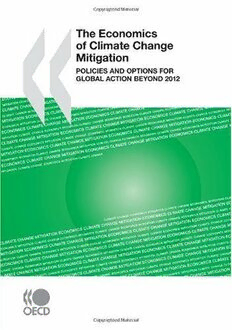
The Economics of Climate Change Mitigation: Policies and Options for Global Action beyond 2012 PDF
306 Pages·2009·2.468 MB·English
Most books are stored in the elastic cloud where traffic is expensive. For this reason, we have a limit on daily download.
Preview The Economics of Climate Change Mitigation: Policies and Options for Global Action beyond 2012
Description:
Against the background of a projected doubling of world greenhouse gas emissions by mid-century, this book explores feasible ways to abate them at least cost. Through quantitative analysis, it addresses key climate policy issues including: an ideal set of climate policy tools;;the size of the economic and environmental costs of incomplete country or sector coverage of climate change mitigation policies;how to concretely develop a global carbon market;;the case for, and what can we reasonably expect from;D and technology support policies; an; the incentives for major emitting countries to join a climate change mitigation agreement.Table of Content :Acronyms and AbbreviationsExecutive SummaryChapter 1. Greenhouse Gas emissions and the Impact of Climate Change-IntroductionPast emission trends-Projected emission trends-The consequences of climate change-Risks and uncertainties-Scenarios for stabilising GHG emissions.Chapter 2. The Cost-Effectiveness of Climate Change Mitigation Policy Instruments-Introduction-A simple framework for thinking about climate mitigation policy instrument-Instruments to mitigate climate change-Interactions across policy instrumentsChapter 3. Mitigating Climate Change in the Context of Incomplete Carbon Pricing Coverage: Issues and Policy Option-Introduction-Implications of incomplete coverage for the costs and effectiveness of mitigation action-Implications for carbon leakage and competitiveness-Pros and cons of policy alternatives to address leakage and competitiveness issues-Incorporating deforestation and forest degradation into an international mitigation action planChapter 4. Towards Global Carbon Pricing-Introduction-Removing environmentally-harmful energy subsidies-The direct linking of emission trading schemes-The role of emission crediting mechanisms and related challenges-The potential and limitations of sectoral approaches-Regulatory issues and the role of financial markets.Chapter 5. Technology and ;D Policies-Introduction-Recent spending trends in energy-related Policy instruments to stimulate;D technology deployment.Chapter 6. Regional Incentives for Global Action-Introduction-Broad-based international mitigation and incentives for action-Enhancing participation incentives through co-benefits of mitigation policies-Enhancing particiaption incentives through financial transfers.Chapter 7. Building Support for Global Action-Introduction-A review of the instruments currently in use-Copmaring mitigation costs and emission reductions across countries-Policies to building global support for action.References.Annex 1. Long-Run GDP Growth Framework and Scenarios for the World Economy.Annex 2. An Overview of the OECD ENV-Linkages Model.
See more
The list of books you might like
Most books are stored in the elastic cloud where traffic is expensive. For this reason, we have a limit on daily download.
